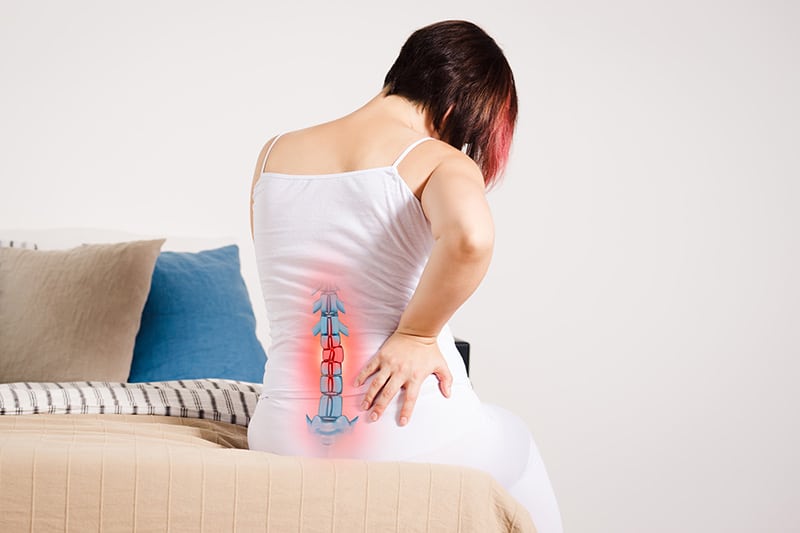What is anterolisthesis? Also known as spondylolisthesis, anterolisthesis is a spinal condition that occurs when the vertebra body (drum-shaped area in front of vertebrae) slips forward. Anterolisthesis most commonly occurs in the lower back (lower lumbar spine). However, other parts of the body such as the arms or the legs can also be affected. Primary care physicians are often the first to treat spondylolisthesis and the patient will then be evaluated by chiropractors or spine surgeons along with their team of physicians, nurses, physical therapists, and pain management specialists. Professional chiropractic billing services can help these specialists report the condition and the treatment provided on the medical claims using specific ICD-10 codes.
Spondylolisthesis and spondylolysis are not the same. While spondylolysis is only a defect in a portion of the spine called pars interarticularis (a portion of bone joining the facet joints in the back of the spine), spondylolisthesis is anterior slippage of one vertebra over another in the front of the spine, unilateral or bilateral.
To establish the extent of the damage, the amount of slippage is graded on a scale from mild to severe, marked from 1 to 4. While Grade 1 is mild with less than 25% slippage, Grade 4 is severe with greater than 75% slippage. This grading scale helps determine the severity of the condition and the treatment necessary. The symptoms of anterolisthesis can vary greatly depending on the Grade and the area affected.
Symptoms, Causes and Treatment
Pain is the major symptom, while other symptoms include muscle spasms, pulsating or tingling sensations, and inability to feel hot or cold sensations, poor posture, and weakness. Some patients face difficulty in walking, limited body movement or loss of bladder or bowel function.
Anterolisthesis can be caused by – any trauma experienced in a fall or an accident, strenuous physical exercise, aging, or any underlying conditions such as tumor or arthritis. Spine Health discusses 6 recognized causes of slippage as –
- Dysplastic spondylolisthesis (includes congenital)
- more common in the pediatric population
- females more commonly affected than males
- Isthmic spondylolisthesis
- includes lytic or stress fracture
- more common in the adolescent and young adult population, especially males
- may go unrecognized until symptoms develop in adulthood
- Degenerative spondylolisthesis (Pseudospondylolisthesis)
- degenerative disc disease and degeneration of the facet joints
- occurs in adults – more common in females than males with increased risk in the obese
- Traumatic spondylolisthesis
- secondary to a fracture of the neural arch
- occurs after fractures of the pars interarticularis
- most common after trauma
- Pathologic spondylolisthesis
- occurs from bone disease or connective tissue disorders such as metastatic disease, tumor, osteoporosis, etc.
The condition is diagnosed using a physical examination or by evaluating the patient’s symptoms. Other imaging tests that might be recommended to examine bone defects, and assess any nerve damage include X-ray, CT (computed tomography) scan or MRI scans.
ICD-10 Codes for Spondylolisthesis
- M43.1 Spondylolisthesis
- M43.10 Spondylolisthesis, site unspecified
- M43.11 Spondylolisthesis, occipito-atlanto-axial region
- M43.12 Spondylolisthesis, cervical region
- M43.13 Spondylolisthesis, cervicothoracic region
- M43.14 Spondylolisthesis, thoracic region
- M43.15 Spondylolisthesis, thoracolumbar region
- M43.16 Spondylolisthesis, lumbar region
- M43.17 Spondylolisthesis, lumbosacral region
- M43.18 Spondylolisthesis, sacral and sacrococcygeal region
- M43.19 Spondylolisthesis, multiple sites in spine
- M43 Other deforming dorsopathies
- M43.0 Spondylolysis
- M43.00 …… site unspecified
- M43.01 …… occipito-atlanto-axial region
- M43.02 …… cervical region
- M43.03 …… cervicothoracic region
- M43.04 …… thoracic region
- M43.05 …… thoracolumbar region
- M43.06 …… lumbar region
- M43.07 …… lumbosacral region
- M43.08 …… sacral and sacrococcygeal region
- M43.09 …… multiple sites in spine
- M43.0 Spondylolysis
Anterolisthesis – Treatment and Management Options
Depending on the patient’s condition, treatment options can range from bed rest to surgery. If the patient becomes symptomatic, rest will be recommended to eliminate the pain, and they can resume normal activities when the pain resolves. For mild slippage, often a short period of bed rest, gentle exercise or pain medications will be advised. Medications prescribed may include non-steroidal anti-inflammatory drugs (NSAIDs) that can be used to treat the pain and inflammation caused by the condition. Steroids and opioids may be needed for more acute pain. At the same time, for severe cases physical therapy, chiropractic therapy or even surgery may be needed.
Physical therapy can treat complicated symptoms along with exercise programs to improve mobility of the spine, strengthen the abdominal/back muscles, and lessen painful movement of the bones in the affected area. Chiropractic treatment may help move the misaligned vertebrae back into its original position. Ultrasound, electric stimulation, hot/cold packs or manual therapy can reduce pain and muscle spasms. Other options include decompression, and spinal fusion. In decompression procedure, bone or tissue is removed to release pressure on the vertebrae and associated nerve roots. During spinal fusion procedure, a piece of bone is transplanted into the back of the spine, which is meant to stabilize the spine.
Surgery is considered as a last option for the treatment of anterolisthesis, if the vertebra continues to slip or if pain persists despite all the other treatments. The procedure may include adjusting the vertebrae with plates, wires, rods, or screws.
Physicians, chiropractors or physical therapists treating anterolisthesis can rely on an experienced medical billing company to submit their medical claims without errors. AAPC has reported that during documentation, medical necessity for any procedures is shown through – history and physical (duration/character/location/radiation of pain, activity of daily living (ADL) limitations and physical examination), evidence/support of prior conservative treatment measures attempted, imaging reports pertinent to performed procedure, operative reports and outpatient records before, during, and after the procedure that support the medical necessity of performed procedures.




